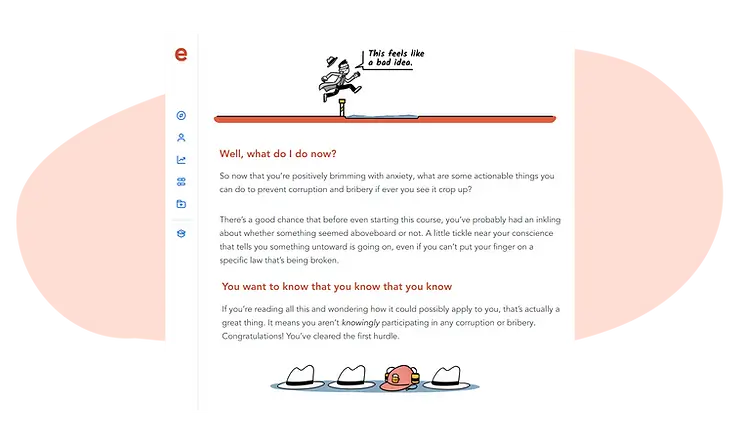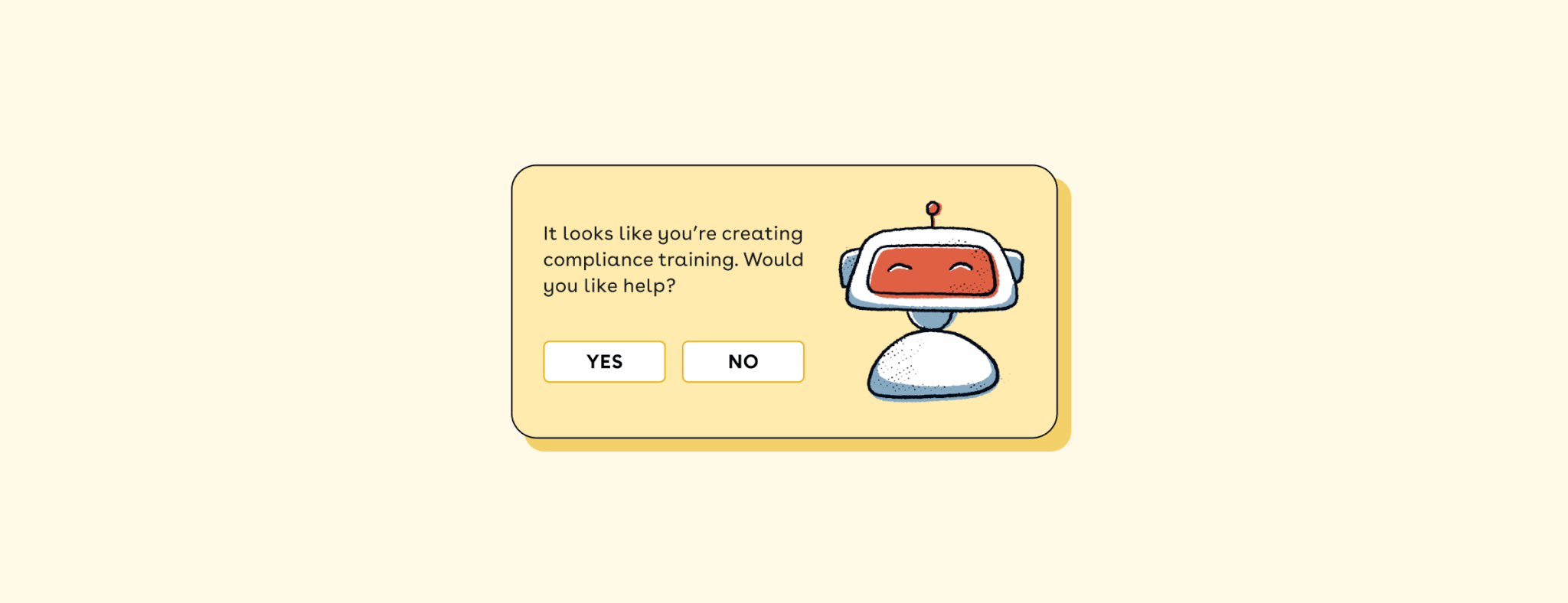Imagine you find out a coworker has been making extra money by doing side work for one of your company’s clients. Or, imagine you attend a happy hour hosted by a company vendor, and overhear a colleague sharing details of an upcoming feature release for your product. Perhaps during weekly Zoom meetings, a colleague repeatedly makes inappropriate comments about a fellow team member’s age? Conflicts of interest, disclosing confidential information, age discrimination — each of these scenarios represents a particular flavor of unethical behavior but, of course, there are many more.
There is unethical behavior in the workplace when conduct doesn’t align with a company’s values and standards of ethical conduct. It can be frustrating, have a direct impact on people’s ability to do their jobs, and create a toxic work environment that leads to decreased satisfaction and productivity, costly lawsuits, and higher levels of stress and burnout. In fact, unethical workplace cultures are the number one reason employees quit. On the flip side, research shows a culture of integrity leads to:
- 2.1x higher employee engagement
- 12% increase in employee productivity
- 9x fewer instances of misconduct
What are workplace ethics?
Ethics are moral principles that guide a person's behavior. In the workplace, ethics influence employee behavior by helping people understand what is considered “right” and “wrong,” as well as how to interact with team members, clients, and other people in an organization’s broader community.
While there’s often overlap between what’s legal and what’s ethical, it’s important to understand that ethics extend beyond the law. For example, it may not be illegal to gossip about your co-worker’s not-yet-announced retirement on social media, but it could definitely be considered unethical to spread personal news that someone asked you to keep confidential.
A company may define their expectations regarding ethics and ethical behavior in their Code of Conduct. In Ethena’s Code of Conduct course, we define ethical conduct as “acting with the highest standards of personal and professional integrity.”
“Floor” vs. “ceiling”: How to approach workplace ethics
Workplace ethics (also known as business ethics) have historically been framed in a somewhat negative context. For a long time, organizations simply approached ethical standards as a list of all of the things employees shouldn’t do. Leadership outsourced the task of creating standards to the legal team or Human Resources, packaging these standards into lengthy (often, yawn, boring) legal documents that no one really read — or trainings no one paid attention to. Think of this as the “floor” approach to ethics: While it may meet legal requirements, it certainly doesn’t inspire employees.
In order to actually improve employee behavior, we’ve learned that ethics and compliance programs need to do more than “check the box” — they need to be engaging, compelling, and inspiring. After all, business ethics aren’t just what employees shouldn’t do; they’re what everyone should aim to do! Think of this as the “ceiling” approach to ethics. By setting a high standard for ethical behaviors in the workplace, organizational leaders can foster a culture where people strive to be the best they can be — not only as employees, but also as individuals.
As Rob Chesnut, author of Intentional Integrity: How Smart Companies Can Lead an Ethical Revolution and former Chief Ethics Officer at Airbnb, said: “There are things that you have to do to technically comply with the law, but those are not the things that you do to really send a message to your employees that integrity matters.” In other words, a true culture of integrity — the kind of culture more and more employees are seeking — is one that moves beyond compliance.
What does ethical behavior look like in the workplace? 3 examples
Many organizations are now taking a “ceiling” approach to ethics by articulating their commitments to — and expectations for — employees beyond what’s legally required.
So, what do day-to-day scenarios involving ethical behaviors in the workplace look like? Here are three examples:
1. An uncertain conflict of interest
An employee at your company realizes that their moonlighting gig — to help a friend who just founded a startup — might actually be a conflict of interest because both companies are in the same industry. The employee brings their concern to your legal, compliance, or Human Resources team, discloses the work they’ve been doing, and works with leadership to understand if it’s a permitted outside business activity.
2. A questionable vendor opportunity
A vendor is trying to sell to a sales manager at your company. The vendor contact invites the manager to a fancy conference. While the manager wants to go (and thinks there would be real business value in attending), she also wonders if this is ethically inappropriate given that she is still evaluating their bid. She asks your company leadership for guidance.
3. Referring of family members
A position opens up at your organization, and a longtime employee knows that his cousin would be perfect for a role on his team. Instead of saying, “Hey, apply, and I’ll put in a good word,” he brings the situation to the talent team and discloses the personal relationship. The talent team appreciates that the employee brought them a great candidate, and asks the employee to recuse himself from the interview process to ensure a fair hiring process.
How to foster an ethical workplace culture: 4 ways
If you want to inspire integrity and encourage employees to act ethically, it’s important to integrate company ethics into every aspect of your organization. Here are four ways to foster an ethical work environment from top to bottom.
1. Create a code of conduct and code of ethics
A code of conduct and code of ethics are sets of guiding principles that outline your organization’s expectations for employees, clients, and collaborators to make clear the commitment to ethical conduct. Think of a code of ethics as a more general framework that sets the stage while the code of conduct informs specific actions. An effective code of conduct defines your mission and values, and then connects these ideals to expected day-to-day behavior of individuals. It sets clear expectations for employee behavior and how the company responds when those expectations aren’t met. Also, it instructs employees on how to file a complaint and report inappropriate behaviors that support codes of conduct. In the U.S., public companies are the only organizations legally mandated to have a code of conduct, but they’re generally seen as best practice for organizations of all sizes.
2. Interview for values
Workplace cultures and values play an influential role in the hiring process. In fact, Jobvite’s 2021 U.S. jobseeker report found that “company culture and values” was the third most important factor in job acceptance (more important than job security, work-life balance, or even healthcare benefits). To attract employees who are aligned with your company’s values, consider including ethical expectations as part of your interview process. You can do this by conducting values interviews with a clear evaluation rubric.
3. Get leadership involved
As Chief Ethics Officer, Chesnut started a unique program called “Integrity Belongs Here” to promote a culture of ethical employee behavior within the company. As part of the program, employees received an ethics orientation — often delivered by Chesnut himself — followed by ongoing opportunities to talk to ethics advisors about any questions that came up in their jobs.
This is a great example of how you can “set the tone at the top.” If you want to discourage unethical conduct and encourage ethical behavior, you need buy-in and role modeling from leadership. Make sure business leaders demonstrate good ethical behavior and acknowledge employees who do the same.
4. Invest in ongoing training
Lastly, building an ethical work environment is not a one-and-done effort — it’s an ongoing, evolving process. While it’s important to invest in annual training, it’s also essential to keep conversations about ethical behavior alive over time. That’s why Ethena’s Code of Conduct training is configurable: so that admins can deliver short lessons on important policies and procedures at the moments that matter. For example, a company can deliver its “Gifts and Entertainment” training nudge before the holiday season for maximum impact and retention. Or send a “Drinking Excessively” training nudge before a holiday party as a reminder of what acceptable and ethical workplace behavior looks like.

Final thoughts
Today’s employees expect more from their employers. They want to know that your organization isn’t just about making a dime; you also care about how work is done, and that it’s done right. By establishing a strong, clear set of moral principles, you can build a healthier and ethical work environment that sets your organization up for long-term success.

Ethena is a modern compliance training platform that delivers current, cringe-free content that employees actually enjoy. Request a sample course to see for yourself! If you’re ready to bring complex issues to life through thoughtful real-world examples, dynamic multimedia, and actionable next steps, let’s talk to see if Ethena is right for your company.








